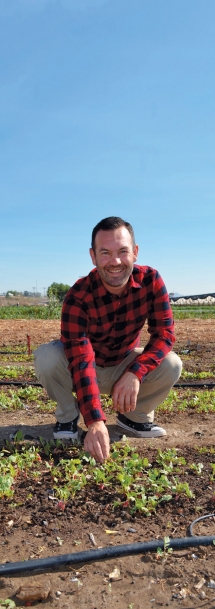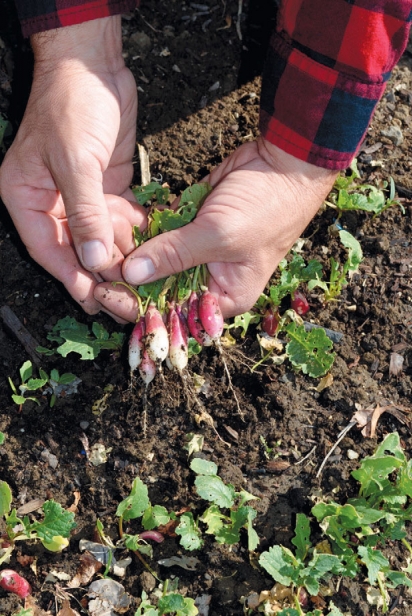Baby Roots, Big Plans
A small revolution is underway at Mike Roberts’ Baby Root Farm. A tiny revolution, really. He’s using a half-acre parcel in Camarillo to improve the environment, educate a new generation of farmers, oh, and grow food people can feel good about consuming.
Located on McGrath Family Farm’s organic property that’s also home to The Abundant Table, Roberts’ farm of “roots, shoots and froots,” as he puts it, broke ground last May. He grows mini root vegetables like Japanese Hakurei turnips, French breakfast (D’Avignon) radishes, baby greens and sweet pea shoots, to name a few. The farm’s associate farmers grow Gaviota strawberries as part of Baby Froot Farm.
Talking to Roberts, 43, it quickly becomes clear that he’s more than a farmer. He’s a businessman. An ag evangelist. A process wonk. Someone with heart, drive and passion whose lifetime goal is “a farmer/gardener in every home in the world.”
An Oxnard native, he came to farming after a career in sports bookmaking (a service for gamblers to wager on sporting events). The switch didn’t come immediately, he says. All he knew was that he wanted to devote his life to something meaningful. “I was also interested in repairing my health and well-being, so I began to seek out healthier food,” he says.
A visit to McGrath Family Farm’s roadside market in 2011 and meeting Phil McGrath piqued his interest in digging in the dirt. “Phil was so passionate about organic farming and so clear about his role in life to preserve farmland for future generations that I knew growing food was an option I wanted to explore.”
Roberts began an apprenticeship with McGrath to learn how food was grown. The physically demanding work paid slightly above minimum wage and involved tasks like addressing endless rows of weeds, moving sprinkler pipes and tractor work. Through it all, McGrath encouraged Roberts to begin exploring new systems.
“He told me agriculture is always evolving, and I have a feeling we’re at the crossroads of a major shift in food production.” As he soaked up knowledge from McGrath over the years, he went to workshops, researched what other farmers were doing around the world, and he farmed.
As I surveyed the land with Roberts on a recent visit, he spotted something red amid the fields of green—the first strawberry of the season. He offered it to me, a relative stranger equipped with a notebook, as a broad smile spread across his face. The strawberry was perfect.
Food is fundamental, Roberts says. “It doesn’t matter what your background, what your gender is, what your race is, we all have to eat. … It felt like this was something I could feel good about and maybe make a difference in.”
Roberts started using regenerative agriculture practices in 2014, with his home garden serving as his first testing ground. “I knew I wanted to find or develop a system of production-based agriculture that maintained a high level of production, while improving the environment, the lives of those working in the system and that was profitable so the farmers could make a fair living,” he says.
He has metrics in place to track how they’re doing environmentally, socially, economically and educationally to ensure they stay true to their mission.
Operational details of his farm fill the dry-erase whiteboards in his small office. There’s a definition of regenerative agriculture, a current crop roster and statements like: “We also grow California native plants and have giant aspirations to grow the next generation of regenerative farmers.”
Roberts and his team approach environmental regeneration from several angles, he says: 30% of the parcel is planted with California natives, they use a no- to low-till system and “meticulously track” water and fossil fuel use. He mentions tracking organic matter in the soil and moving to more complex measurements like carbon sequestration, as well as tissue and leaf analysis.
“My aim is to help [farmers] start their own regenerative farm businesses. It will be up to them—and the support of their communities—to ensure they are making a fair living wage.”
“Farming is inherently risky,” he sums. “And all gamblers, the successful ones, they want to take very calculated risks. … My general guideline is 80–90% tried and true methods and 10–20% wild experimentation.”
Baby Root Farm products are available at The Abundant Table Farm Store in Camarillo, and from the McGrath Family Farm booth at the Ojai Certified Farmers’ Market. For more info, visit BabyRootFarm.com.










